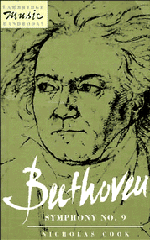1 - Sketches and myths
Published online by Cambridge University Press: 08 January 2010
Summary
The sketches
One of the best known facts about Beethoven's Ninth Symphony, if it is a fact, is that the work was many years in the making.
We know this because of the sketches. Beethoven sketched as many artists sketch: habitually and perhaps compulsively. He worked things out on paper that other composers of his time worked out in their heads or at the keyboard. Sometimes he doodled; there are sketches that look more like limbering-up exercises or mental diversions than serious attempts at composition. But in other sketches we can see him planning out major works in exhaustive detail, testing and refining them over a period of weeks or months, or even years, before starting to write out the final score. Moreover, Beethoven kept his sketches after the works to which they referred were completed. Every time he moved – which was frequently – the sketches went with him; they were dispersed only after his death.
In his early years, Beethoven sketched on single sheets of paper. Interesting as such sketches may be, there is a limit to what they can tell us, because there is no way of telling in what order they were used. But in 1798, Beethoven started to use sketchbooks rather than single sheets. These sketchbooks were bound before he used them, and on the whole he worked through each book in sequence from the first page to the last.
- Type
- Chapter
- Information
- BeethovenSymphony No. 9, pp. 1 - 25Publisher: Cambridge University PressPrint publication year: 1993



